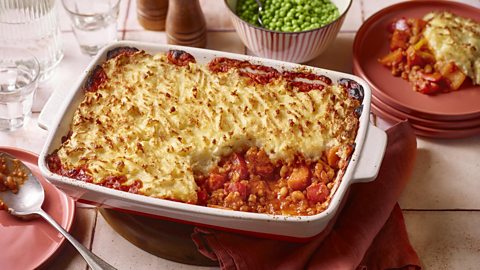Are you getting your 30 plants a week? Plant points explained
Move over five-a-day, it’s all about 30 plants a week. But what counts as a plant point? And why aim for 30?

You’ve likely heard about the concept of eating 30 plant points a week – a goal that focuses on variety rather than volume.
The idea is straightforward: A point is given for every ‘new’ plant you eat in a given week (well, more or less – we’ll get into that later). By including 30 different plant-based foods in your meals and snacks each week, we’re covering more bases when it comes to the broad spectrum of nutrients we need to keep our bodies, particularly our guts, healthy.
The theory emerged from research carried out as part of the American Gut Project, a crowd-sourced project involving more than 10,000 participants. Its goal is to better understand the gut microbiome in health and disease.
“They discovered that participants who ate 30 or more different types of plants per week had gut microbiomes that were the most diverse – and hence health promoting,” says Dr Shireen Kassam, professor, author and founder and director of Plant-Based Health Professionals UK.
That’s where the magic number 30 came from – this was the tipping point researchers found which made the most marked difference to participants’ health.
Related articles
What counts as a plant point?
Beneficial plants are generally categorised into six groups: wholegrains (like brown rice, oats, barley and quinoa) vegetables, fruit, legumes (think lentils, chickpeas and beans), nuts and seeds and herbs and spices. All of those will count towards your quota.
Yep, that means coffee and dark chocolate (with 70% cocoa solids or more) are on the list, as they’re technically derived from seeds. Tofu – made with soya – counts too.
The key here is variety. There are no prizes for eating the same plant twice, besides the obvious health-related ones, as Kassam points out: “Most beneficial foods have a dose effect, the more the better, within reason. But, you just can’t count it more than once in a week.”
And when we say these plants must be ‘different’, we don’t just mean in terms of species. Different colours of the same fruit or vegetable are each worth separate points – think orange and yellow peppers, and green and red apples.
This Hairy Bikers recipe uses colourful mixed peppers – each colour will contribute another plant point
“This is due to the different chemicals found in different coloured plants,” explains dietitian Catherine Rabess, author of The 30 Plan.
“The function of the polyphenols (a particular group of compounds) can vary greatly dependent on the colour and type of a food.”And, the more variety of these hero compounds we get, the better.
“Best described as the bodyguards of the gut, polyphenols have antioxidative, anti-inflammatory and antimicrobial activities, which can improve our health. They can defend against harmful invaders as well as reduce inflammation and oxidative damage that can be linked to chronic disease.”
Most plants from the six groups count as one whole point, although some – herbs and spices, for instance – are each a quarter of a point, mainly due to the small amount we’re likely to eat of each.
Recipes for eating the rainbow
What *doesn’t* count as a plant point?
Plant points are all about whole and minimally processed foods. Generally, the more an ingredient is refined and altered, the more diminished its impact on our health. So, not all plant-derived foods will be worth a point.
“Anything that is not from a whole food does not count – so that’s anything that has not come naturally from the derivative (the source) and has gone through processing to get to the final product,” says Rabess. “Processing often reduces or eliminates the proven beneficial ingredient. That’s not to say it is not healthy, but it cannot count towards your plant points.”
For instance, white bread and pasta is made with the inner part of the wheat grain, which has been stripped of the fibre-rich bran and germ. Same goes for white rice.
However, brown pasta, rice and bread are examples of wholegrain foods, where the grain has been left intact, which is why they count towards your 30.
Use brown rice rather than white – like in this recipe – and you’ll soon reach your 30 points
Fruit juice is another instance of processing that changes the make-up of an ingredient. It might count towards your five-a-day in some instances, but due to its lack of fibre, you can leave if off your plant point tally for the week.
How easy is it to eat 30 points?
Hitting 30 different types of plants every week might sound difficult – but you’d be surprised. Given how broad the spectrum of foods that count is (not forgetting the array of colours that the same vegetable or fruit can come in), with a little bit of planning and practice, it’s a target many of us could see ourselves achieving.
You may find that your points rack up easily over the first couple of days but, if you batch cook or tend to keep the same meals on regular rotation, they might slow down dramatically after that. Keep momentum by bringing batch-cooked base dishes, like a lentil stew back to life in different ways with added ingredients, and always consider dishing up an extra side of veg with your meals.
Barbecue bean pie
You don’t need to spend loads on specialist ingredients, you can reach your points using tinned, frozen and dried budget-friendly ingredients

Mixed nuts, seeds and dried fruits are great for snacking on as well as adding extra flavour and texture when sprinkled on vegetables, salads and breakfasts. They can easily give a nutritional boost to desserts too.
There are other easy wins for boosting the plant variety in your diet, like swapping in brown rice, pasta and bread for white every so often.
This needn’t get costly: buy pre-packaged products that feature a mix of colours of types of ingredients, like bags of frozen mixed sliced peppers or berry medleys, and tins of mixed bean salads (remember, it’s not just fresh produce that counts!) and you’ll soon hit your 30 points for the week.
Why is gut health so important?
“Digestive enzymes help to break down carbs, protein and fats in your food into smaller molecules so they can be absorbed into your body. The gut also removes waste products while absorbing water, salts and electrolytes, and hosts the gut microbiome – it’s a big, bustling ecosystem that supports many bodily functions,” Rabess explains.
“Gut microbes also support immune function (70% of the immune system resides in the gut), hormone regulation, inflammation regulation and communication between the brain and the gut.”
When the gut is unhappy, you might well know about it, think bloating, constipation and stomach pains. However other symptoms of poor gut health might not be as obvious.
“The absence of gut symptoms doesn’t automatically mean you have good gut health,” says gut health scientist, dietitian, nutritionist and author Megan Rossi, aka The Gut Health Doctor. “This is because our gut health extends beyond digestive symptoms to impact areas like your mental health, heart health and such.
“However, unlike many other organs like our heart or kidneys, there is currently no single tool to assess gut health.”In short: look after your gut, and your gut will look after you.
Plant-heavy recipes to please your gut
Originally published February 2024